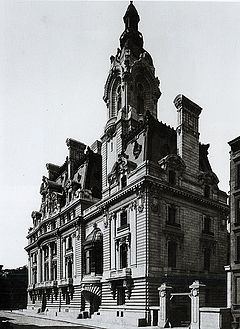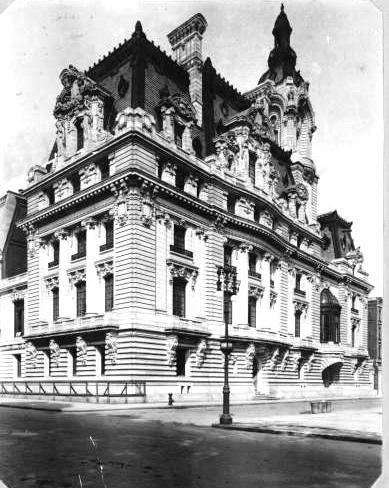Type Residence Completed 1911 Opened 1911 Demolished 1927 | Construction started 1897 | |
 | ||
Cost 7 million USD (equivalent to $177,175,000 in 2015) Similar Cornelius Vanderbilt II House, Vanderbilt houses, Charles M Schwab House, York Mansions, Mrs William B Astor Hou | ||
The William A. Clark House, also known as "Clark's Folly", was a mansion located at 962 Fifth Avenue on the northeast corner of its intersection with East 77th Street on the Upper East Side of Manhattan. It was demolished in 1927 and replaced with a luxury apartment building.
Contents

Construction

William A. Clark, an enormously wealthy entrepreneur and politician from Montana, commissioned the New York firm of Lord and Hewlett to build the house in 1897. The house was completed in 1911, after numerous legal disputes, at a cost of $7 million (equivalent to $179,925,000 in 2016). The house contained 121 rooms, 31 baths, four art galleries, a swimming pool, a concealed garage, and a private underground rail line to bring in coal for heat.

It was reported that Clark bought a quarry in New Hampshire, at a cost of $50,000 (equivalent to $1,285,000 in 2016), and built a railroad to get out the stone for the building. He also bought a bronze foundry employing 200 men to manufacture the bronze fittings. In addition, he imported marble from Italy, oak from Sherwood Forest in England, and parts of old French Châteaus for the interior.

The building of the mansion is described in the bestselling biography of Clark's daughter, Huguette, and her family, Empty Mansions: The Mysterious Life of Huguette Clark and the Spending of a Great American Fortune by Bill Dedman and Paul Clark Newell, Jr.
Exterior

The house had 250 feet on 77th Street and 77 feet on Fifth Avenue, more than any other rich man on Fifth opposite the park, except for Andrew Carnegie. The Fifth Avenue front was large for a New York house with three bays of granite topped by an enormous dormer.
On 77th Street the house featured a long facade rising to an even more elaborate dormer arrangement, set against a steep mansard roof. The house featured a spectacular four-sided tower with a three-story-high inward-curving arch topped by an open pergola that was said to have been visible from almost anywhere in Central Park.
Interior
The house rose nine stories with Turkish baths below ground level, laundry rooms on the top floor and many Greek marble columns. There was a Numidian marble fireplace in the banquet room that measured 15 ft. across with life-size figures of Diana and Neptune. The 120 rooms were filled with medieval tapestries and artwork. In the breakfast room, there were 170 carved panels with no two being identical.
On the second floor was a rotunda, 36 ft. high, of Maryland marble with eight Bresche violet columns, used as the statuary room. The room opened onto a conservatory of solid brass and glass, 30 ft. high and 22 ft. wide. Across the rotunda was the marble-paneled main picture gallery that was 95 ft. long and two stories high. An organ loft housed the largest chamber organ in America with 62 “speaking stops.”
There were 25 guests rooms with their own baths, 35 servants’ rooms with men’s quarters (to the east) and female rooms (to the west). There was also a Gothic library that was 90 ft. long featuring a beamed ceiling and immense carved fireplace.
Clark's art collection included works by Eugène Delacroix, Jean-François Millet, Jean-Baptiste-Camille Corot, John Constable, François Boucher and Charles-François Daubigny. It was reported that he spent $200,000 (equivalent to $5,141,000 in 2016) for the Gobelin tapestries owned by Prince Murat and $350,000 (equivalent to $8,996,000 in 2016) for those of the Earl of Coventry.
Demolition
In 1925, upon Clark's death, his widow and daughter, Huguette Clark, decamped to 907 Fifth Avenue, where the annual rental for a full-floor apartment was about $30,000. Shortly thereafter, the mansion was sold to Anthony Compagana for $3 million (equivalent to $40,970,000 in 2016) who had it torn down, just 19 years after being built. It was replaced with the present luxury apartment building at 960 Fifth Avenue.
Critical reception
Montgomery Schuyler, in a column titled "Architectural Aberrations" in Architectural Record, stated that the house was “an appropriate residence for the late P. T. Barnum.” He felt the tower was “meaningless and fatuous”; the rounded rustication on the first floor suggested the prototype of “a log house.” At the time, the French style had gone out of fashion and the ornamentation was no longer in vogue. Schuyler wrote that “a certified check to the amount of all this stone carving hung on the outer wall would serve every artistic purpose attained by the carving itself.”
The editor of The Architect called the place “The House of a Thousand Cartouches” and despised the “dolorous and ponderous granite” chosen. At the time, these opinions were widespread, earning the home the nickname "Clark's Folly."
In 2011, however, The New York Times architectural critic Christopher Gray stated the house was, in fact, "a pretty neat house. If Carrère & Hastings had designed it for an establishment client, its profligacy would certainly have been forgiven, perhaps lionized."
